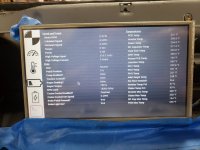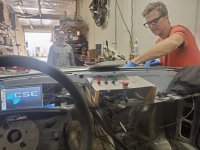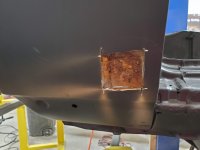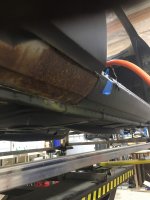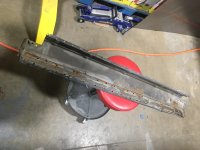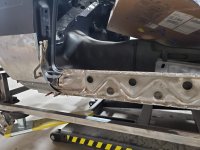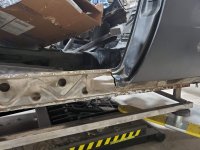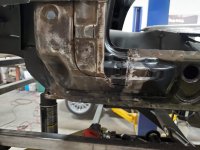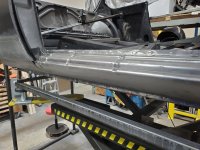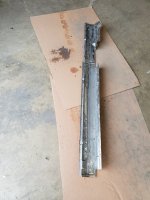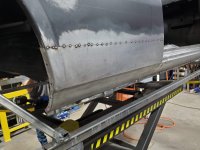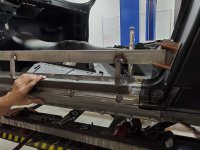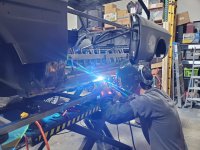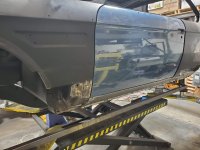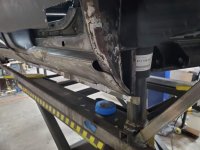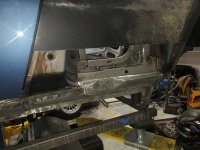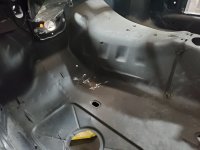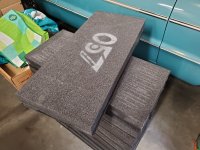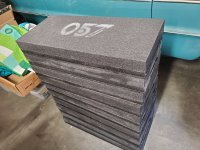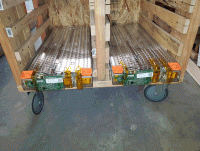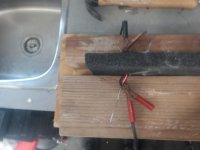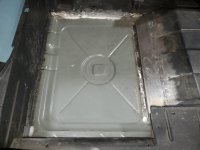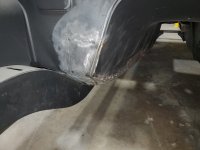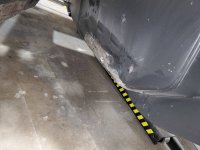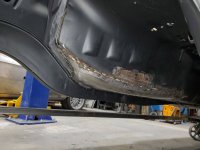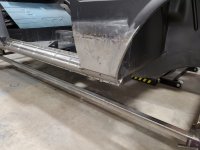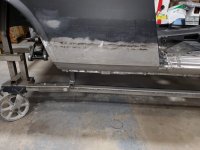With stay at home orders progress has on the Baikal EV has slowed a bit. Considering the fact that Paul had to move his shop to a new location, we aren't doing too badly. Tyler mostly works alone fabricating and welding and we're all keeping our distance. I haven't been to the new shop yet but I've been working on software and my shifter setup from home.
Lots of room in the new shop
Last we "spoke" Tyler had finished the floors and we had installed the suspension. Before moving on to the battery box, we still had to fabricate the support for the rear subframe. Remember, in stock configuration, the rear subframe bolts to the diff, which is then mounted to the floor of the trunk via a rubber isolator mount. The prevents the subframe from rocking on its two main mounting locations at the rear corner of the rockers. Without the stock diff, we must come up with a new way of secure the rear suspension to the car. Paul pioneered this with his car and Tyler improved upon that design with mine. He fabricated a steel truss that he welded into the center of the subframe and extended forward into the prop shaft tunnel. He then reenforced the floor and attached a motor mount from a Chevy Suburban (< $20) to attach the truss to the car. Paul is using fancy Tesla electronic parking brake calipers but I am keeping the stock hand-operated parking brake so we had to work around the cable tubes on my car.





Next was to undo some crude handiwork from a PO in the kick panel area, where the supports had been butchered to make room for speakers.
.
.

While Tyler was working his magic with metal, I was playing with CAD and 3D printing in an effort to adapt the factory automatic trans shifter to my needs. Again, Paul went a slightly different route, using a modern shifter from an Audi. I was hoping to keep the original shifter but realized that, without the detents in the auto trans itself, it was a floppy mess. I also need a way to convert the mechanical motion of the shifter to electrical signals I can send to the Drive Unit Controller of the Tesla motor. The original US auto shifter had gear indicator lights on the steering column so I figured I could repurpose the rotary switch bolted to the side of the old auto trans. If they could make it illuminate light bulbs then I could use it to send 12v signals to the Tesla. But I also needed detents to hold the handle in place so I devised a rotary unit comprised of three sandwiched plates with a round disc in between that had dimples on its edge. Then, a ball bearing and spring could push against the dimples, providing distinct stop points. Skateboard bearings held the D-shaft going through the disc. I'd then have to devise a linkage and lever system to make the shifter spin the shaft, similar to how the original gear selector shaft in the side of the auto trans operated.


After numerous reprints to get the dimple depth right, it actually worked quite well as far as the detents were concerned. But when I tried to use it with the factory rotary light switch I realized that I didn't really understand how it worked. There are about 12 wires coming off that switch and a few hours with a multi-meter proved to me that there were no actual contacts in that switch. Instead, it appears to be a variable resistor (a potentiometer) with dead spots for the various gear positions? I eventually gave up and moved to plan B -- a linear, rather than rotary, system.
This one also took many reprints to get right. It operates somewhat like a player piano. There are 5 lever operated micro switches, one for each gear position (I will use "2" for max regen (or sport, TBD) mode but have no need for the 6th "1" position). "Domes" on a sliding plate, supported by 5 skateboard bearings, activate one switch at a time. the plate has dimples on the bottom edge, with the same ball bearing and spring mech from from rotary prototype provide detents. Linkage from the shifter arm attaches to the plate, making it slide in the housing, which will be attached to the trans tunnel.


It took a while to figure out how far down the shift arm I needed to attach the linkage in order to get the proper "throw" to match the movement of the plate. So far, I've only mocked it up -- the spot-welded washer is not the permanent solution, and I was hesitant to lop off the rest of the arm until I was certain I've got it right -- but it works perfectly. Originally I thought I'd mill the entire thing out of aluminum but seeing it in action, I think that ABS is fine for everything except the sliding plate. You can see it work here:
https://photos.app.goo.gl/841a9FsvRDovn5ZP7
While messing around in CAD, I threw together a quick layout of how 10 Tesla batteries could fit in the engine compartment. Unlike Paul, I'm keeping stock steering and brakes so I had to work around the original ZF steering gearbox. This cost me room for two batteries (Paul fit 12 up front, 2 in the back -- I am putting 10 up front and 4 in the back). Tyler and Paul measured the actual car to see if my plan was feasible and it was, with one major flaw. When the 3/4" steel square tube of the box was added to the measurements, there wasn't enough room between the box and the brake mount. After some discussion, we decided to lop off the end of the steering tube, where the booster normally mounts, and cut into the factory battery tray (I'll only need a small gel cell for powering up electronics prior to energizing the Tesla system). This hurt but was necessary.

How I'm going to relocate my brakes is still TBD but it is 90% likely that I will mount a small single line Wilwood master cylinder to the firewall. That will send hydraulic pressure to a remotely located small slave cylinder, which will move a rod analogous to the original brake pedal rod, into a hydroboost unit, and then to a master cylinder, either original or otherwise (need to figure out where to fit this remote setup and what to do about the two-line system to the original front calipers if I don't go with the original master).
But that's work for a later day. In the meantime, the battery box is coming along nicely. Tyler made Paul's out of aluminum for weight savings but we decided to use steel for mine. It is heavier, but I have 110 pounds less batteries and it has been much faster to build and I figure battery density will improve so much in the coming years that this is just V1 anyway. I'll skin it in something (CF or alum sheet) later for weather protection.
.

